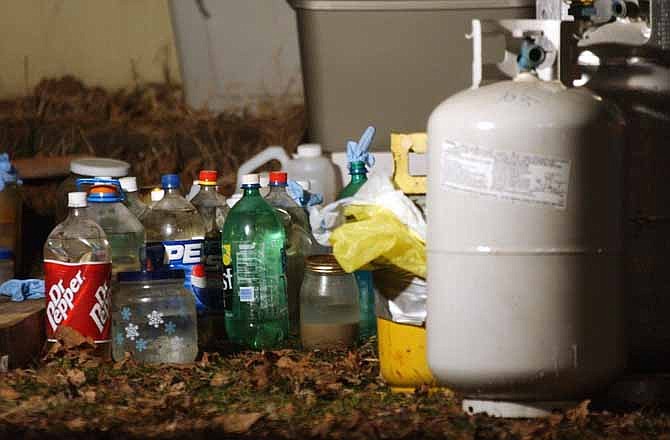SPRINGFIELD, Mo. (AP) - For the past eight years, Shelli Owen has cleaned up meth houses.
In Springfield and surrounding counties, "we've been busy," Owen said, despite an average cost to homeowners of about $3,000.
Owen's clients are cautious folks - cleaning up these properties is not required by the state and is sparsely monitored by the city.
Dozens, maybe hundreds, of houses have been used to manufacture meth in Springfield, but no comprehensive effort exists to ensure those homes have been cleaned of hazardous remnants.
Several states and some Missouri communities that report far fewer meth labs than Springfield require homes be decontaminated before anyone moves in.
In properties where meth has been manufactured, researchers have found chemicals can linger long after the "cook" is over. Those experts say there is evidence that people who move into these spaces can suffer respiratory and neurological problems.
Any long-term health effects are unknown.
"It's the kids and elderly people that are especially susceptible," Owen said.
Owen says she has had clients experience trouble breathing, lightheadedness, and even develop sores in their mouths.
State and federal guidelines are available to help homeowners decontaminate property and the steps to take vary - from cleaning surfaces to gutting the house.
Owen describes the work as similar to decontaminating a place where mustard gas has been unleashed.
Springfield meth labs Dec. 2005 through Jan. 2013
In a house that tests high, carpet, drapes and other porous materials are the first to go. If a lot of meth was manufactured in the house, the walls might come down next. Air ventilation ducts are cleaned and the air is circulated to remove any remaining particulates.
Missouri law requires home sellers and landlords disclose that a meth lab was found on a property if they have "prior knowledge" that volatile chemicals were synthesized there.
But some doubt such information is always disclosed, especially if it might scare away a potential buyer or tenant.
Attorney Tobin Dunn, a partner at Rouse and Dunn Law Group in Springfield, said the law allows for remedies.
But, depending on the specifics of the case, it might not be worth the legal battle if a buyer discovers meth activity went undisclosed, said Dunn, whose firm deals with various kinds of law, personal injury, mediation and conflict resolution.
Over the last three years in Springfield, meth labs have been found in 81 houses, 22 apartments and 22 hotel and motel guest rooms, according to a News-Leader review of police data.
Of those dwellings, some decontamination actions were taken on 31 properties. One property was tested and deemed to be safe. According to records maintained by a city inspector tasked with follow-up after a lab is found, at least one meth lab site was demolished.
Many of the properties that followed cleanup guidelines were hotel and motel rooms.
A look at city records shows little follow-up - if any - to clean properties that were owner-occupied.
When Springfield police discover a meth lab, they vacate the premises and only return after donning a bio-hazard suit, gloves and mask.
The lab components and chemicals are then carefully removed and transported to Rogersville where the Combined Ozarks Multijurisdictional Enforcement Team maintains one of the state's 17 meth chemical collection stations.
Police call it "the bunker."
It is a thick steel, corrosive-resistant, fire-suppressing storage facility where like chemicals are combined and stored before they can be transported again.
"You never know what concoction you might find," said Sgt. Jeff Ussery, a Greene County deputy assigned to the drug task force.
Ussery said for most labs, two officers don full bio-hazard protective gear complete with a self-contained air system.
Chemicals are separated by acids and bases; flammable and inert.
Volatile chemicals are bulked together - slowly, carefully - before being safely stored.
"You can't imagine the man-hours," Ussery said, describing the methodical and potentially dangerous process.
"You can't be lackadaisical when doing it."
Ussery said the bunker provides storage services for seven surrounding counties in southwest Missouri - likely making it one of the busiest facilities of its kind in the country.
From the bunker, the chemicals change hands again.
The Missouri Department of Natural Resources contracts trucks to carry the chemicals from the bunkers to a licensed facility where the waste is "properly disposed," said DNR spokeswoman Renee Bungart.
Bungart said the chemicals are incinerated, blended to make fuel or stored at a permanent facility.
As for the property where the lab was found, the process in Springfield is far less standardized.
After removing lab materials, Springfield police often contact a specific inspector in the city's Building Development Services office.
Inspector Lisa Lee maintains a record of homes, hotel rooms and other properties that have been used as meth lab sites in the city.
Lee acknowledged her records are not comprehensive. The News-Leader obtained a copy of the records and discovered several meth lab sites - identified in police records - were not noted in the report.
For instance, Springfield police reported 108 meth labs in 2011. Lee's records only account for 53.
Whether or not a dwelling was properly cleaned is not always clearly noted either.
Among the properties that were listed, several properties were not cleaned, according to the report.
With the information she receives from police, Lee sometimes sends a letter to the property owner and provides him or her with state and federal guidelines of how to clean up the dwelling.
Following the instructions, Lee notes, is voluntary. Lee also said there is no follow-up on the letter unless the property owner contacts her.
Also, if the property is owner-occupied, Lee does not attempt to make contact regarding cleanup.
Lee said she offers an on-site visit to assist property owners who are interested in properly cleaning up.
Lee said hotels and motels are particularly responsible. "So far, I have not had to twist a lodging's arm," Lee said.
Private residences, especially when the homeowners are suspected of being cooks, are far less likely to show interest in cleaning the property.
Chris Straw, director of Building Development Services, Springfield-Greene County Health Department spokesman Mike Brothers and city spokeswoman Cora Scott were unaware of any other effort in the city to follow up on properties that have been used to manufacture meth.
So-called remediation laws are enforced in about 20 states including Indiana and Tennessee - the only two states that report meth labs at numbers anywhere near Missouri's.
Both states require a meth lab property with high levels of chemicals to be quarantined, cleaned and tested before it can be lived in.
Missouri's lack of cleanup requirements have frustrated some communities in the state, leading a few to take matters into their own hands.
The city of Crestwood, near St. Louis, added a remediation law late last year after the urging of that city's police chief.
With few meth labs ever being found in the city, Police Chief Michael Paillou never gave much thought to cleanup until a year ago, when a large lab was found in a rental property.
It took 16 hours for the lab to be dismantled and all the components removed from the home, he said. A few nearby residents were evacuated while officers did their work.
After the lab was removed and a suspect was in jail, the girlfriend of the alleged cook - along with her two teenage kids - wanted to go back in the house.
"We had no way, legally, to keep them from going back in," Paillou recalled.
"How can we protect the kids because the family is cooking meth? That got us looking."
Information from: Springfield News-Leader, http://www.news-leader.com


